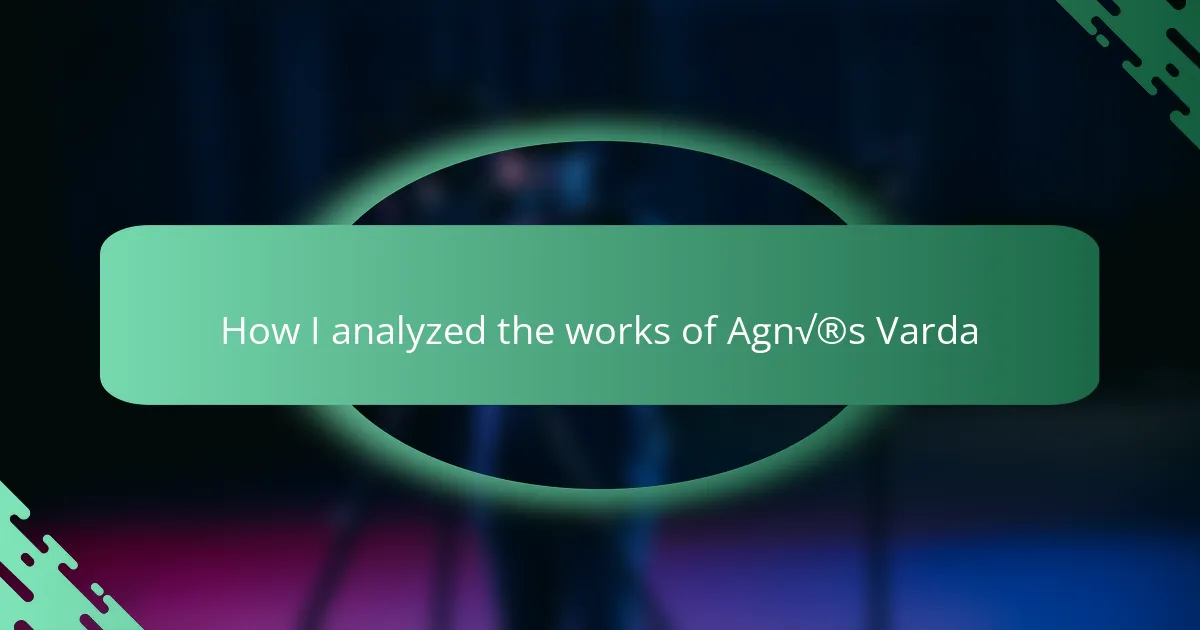Key takeaways
- French cinema, particularly through filmmakers like Agnès Varda, uniquely blends personal narratives with social commentary, allowing deep emotional connections with audiences.
- Key themes in Varda’s work include femininity, the passage of time, and memory, highlighting women’s experiences and societal reflections.
- Varda’s innovative storytelling blurs the lines between documentary and fiction, enhancing authenticity and viewer engagement.
- Analyzing her films provides insights into cultural issues and encourages personal reflection, making her work relevant across generations.

Introduction to French cinema reviews
French cinema is a treasure trove of artistry and innovation that has captivated audiences for generations. Its rich history reflects a blend of technical prowess and profound storytelling, which often challenges societal norms. Have you ever found yourself deeply moved by a film that simply changed your perspective on life? That’s the magic that French films tend to weave.
In reviewing French cinema, it’s essential to appreciate the unique cultural and historical context that shapes its narratives. Films by directors like Agnès Varda often reflect the complexities of human emotion and social commentary. I remember the first time I watched her work; it was a revelation that sparked my curiosity about life’s fleeting moments.
Each review serves not just as an analysis but also as a conversation with the viewer’s heart and mind. Why do certain scenes resonate with us long after the credits roll? It’s this intimate connection between the film and the viewer that makes French cinema reviews an exciting endeavor, revealing the layers of meaning and emotion that lie within.

Importance of analyzing filmmakers
Analyzing filmmakers like Agnès Varda holds immense importance as it deepens our understanding of their artistic choices and the social contexts they portray. From my experience, each frame she crafted pulses with her unique perspective, blending personal narrative with broader societal themes. This kind of analysis enriches our appreciation of her work and encourages us to draw parallels with our own lives.
When I first explored Varda’s films, I was struck by how her storytelling mirrors the complexities of human experience. Delving into her motivations and techniques allowed me to appreciate not only her innovations but also how they resonate with ongoing conversations about identity and representation today.
- Film analysis enhances our understanding of cultural contexts and influences.
- It fosters a deeper connection with the filmmaker’s voice and vision.
- Engaging with their works can spark discussions about contemporary issues.
- Analysis can reveal universal themes that transcend time and geography.
- It empowers viewers to critically evaluate other films and filmmakers.
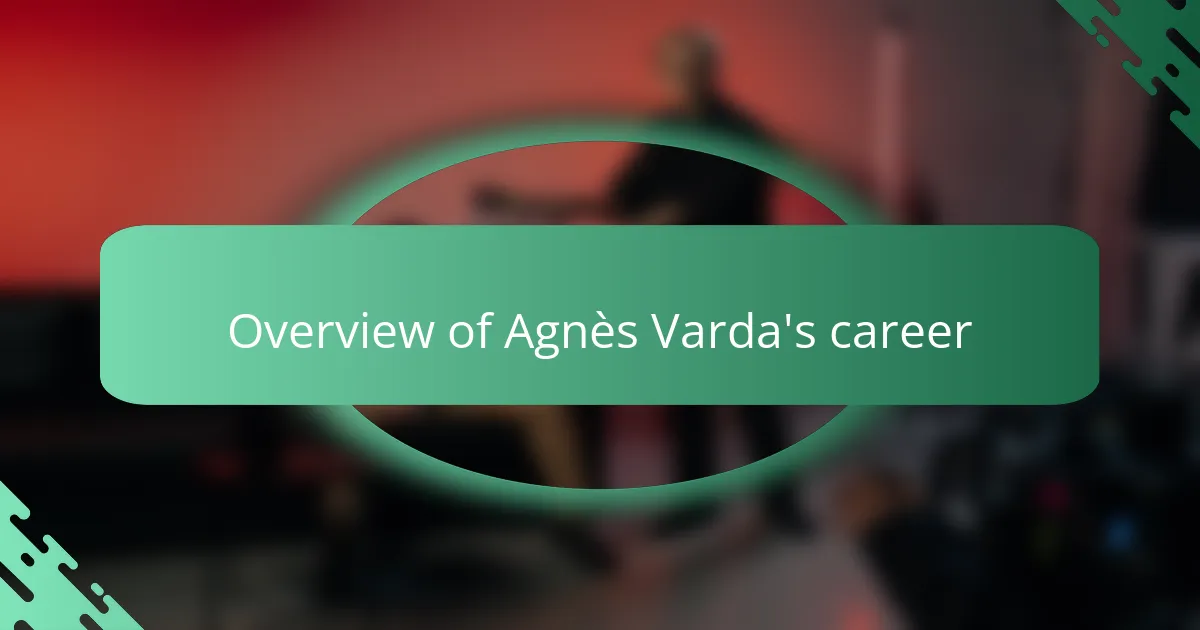
Overview of Agnès Varda’s career
Agnès Varda’s career spans over six decades, making her one of the most influential figures in cinema. Starting as a photographer, she transitioned into filmmaking with her debut feature, “La Pointe Courte,” in 1955. This early work laid the foundation for her unique style, which blended personal narrative with social commentary, and demonstrated her deep engagement with women’s experiences and identity.
Reflecting on her impact, I remember the first time I watched “Cléo from 5 to 7.” It was a revelation; her ability to intertwine existential themes with everyday life struck a profound chord within me. Varda’s work often challenges viewers to reflect on their own lives, making her a beloved figure not just in France, but globally.
Here’s a comparison table that highlights key phases of her career:
| Year | Work |
|---|---|
| 1955 | La Pointe Courte |
| 1962 | Cléo from 5 to 7 |
| 1975 | Vagabond |
| 2000 | The Gleaners and I |
| 2017 | Visages Villages |
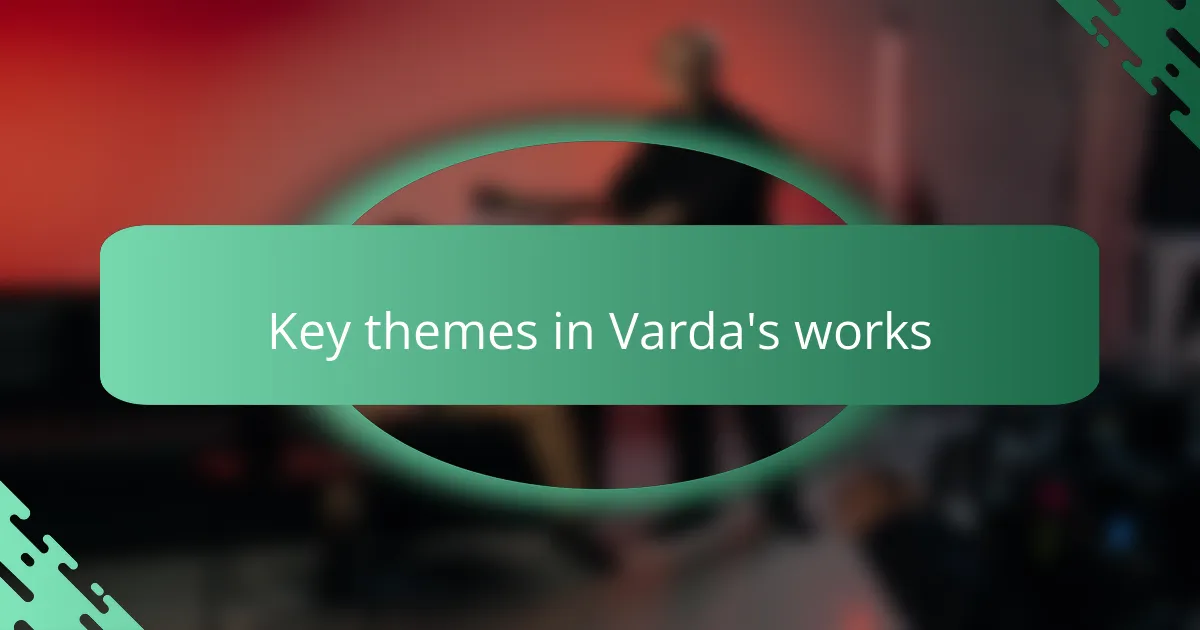
Key themes in Varda’s works
When analyzing Agnès Varda’s works, a few key themes emerge that resonate deeply with audiences. One of the most prominent themes is the exploration of femininity and women’s experiences. Varda often highlights the lives of women, showcasing their strengths, struggles, and complexities, which I appreciate as it brings an honest perspective to the film narrative.
Another recurring motif is the passage of time and memory. In films like “The Gleaners and I,” I found that Varda paints a poignant picture of how fleeting moments shape our identities. This theme resonates with me personally, as I often reflect on how the memories I’ve gathered over time have influenced my own life path.
Here’s a comparison table that showcases themes across several of her iconic films:
| Film | Key Theme |
|---|---|
| Cléo from 5 to 7 | Exploration of femininity and anxiety about mortality |
| The Gleaners and I | Memory, time, and societal reflections |
| Vagabond | Freedom and alienation, the struggle for identity |
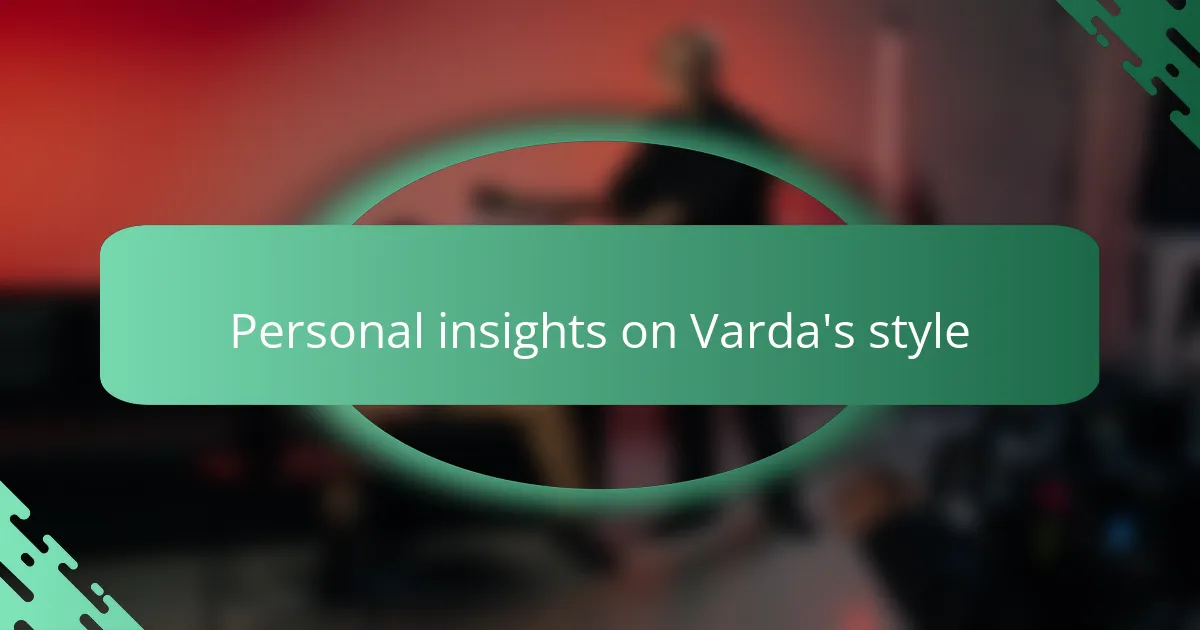
Personal insights on Varda’s style
As I delved into Varda’s style, I couldn’t help but notice her distinct approach to storytelling. Her use of natural light and handheld camera work creates an intimacy that makes you feel like a part of the scene, rather than just an observer. I remember the first time I watched “Cléo from 5 to 7”; it was as if I was accompanying her on a personal journey, feeling every moment of tension and joy. How does one director manage to make such profound connections? It’s her authentic voice and willingness to showcase vulnerability that draws us in.
Varda had an innate ability to blend documentary elements with fictional storytelling. In “The Gleaners and I,” she blurred the lines between reality and narrative, allowing viewers to reflect on social issues while experiencing her personal reflections. I found that her storytelling invites an emotional honesty that many filmmakers shy away from. Each scene seemed to be not just a moment captured on film but rather a poignant reminder of our shared humanity.
Another aspect I admire is her fearless exploration of aging and identity. Varda often celebrated the beauty of imperfection, and it resonated with my own thoughts on how we perceive ourselves over time. Watching “Vagabond,” I was struck by her portrayal of a woman’s untamed spirit amidst societal expectations. It’s thought-provoking to consider: how often do we confine ourselves to fit a mold, and how liberating would it be to break free? Varda encourages us to embrace our true selves, and that’s where the real magic lies in her work.

Methodology for analyzing film
When analyzing the works of Agnès Varda, I focused on her unique narrative style and thematic depth. I paid close attention to her use of personal storytelling and how she blended documentary and fiction. Reflecting on my own experiences watching her films, I found that Varda often evokes a powerful emotional response by drawing from real-life experiences, which I believe is a hallmark of her artistry.
In my methodology, I employed a comparative approach, looking at key elements such as visual aesthetics, character development, and audience engagement. I found it particularly interesting how Varda’s films often challenge conventional storytelling, making the viewer feel like an active participant in the narrative. This immersive experience is something I cherished during my analysis of her body of work.
Here’s a comparison table summarizing my analytical focus:
| Analysis Focus | Key Insights |
|---|---|
| Narrative Style | Blends documentary with fiction, creating a personal connection. |
| Visual Aesthetics | Use of vivid imagery to evoke emotions and enhance storytelling. |
| Character Development | Characters often reflect real-life experiences and societal themes. |
| Audience Engagement | Encourages viewers to reflect and engage with the narrative on a personal level. |
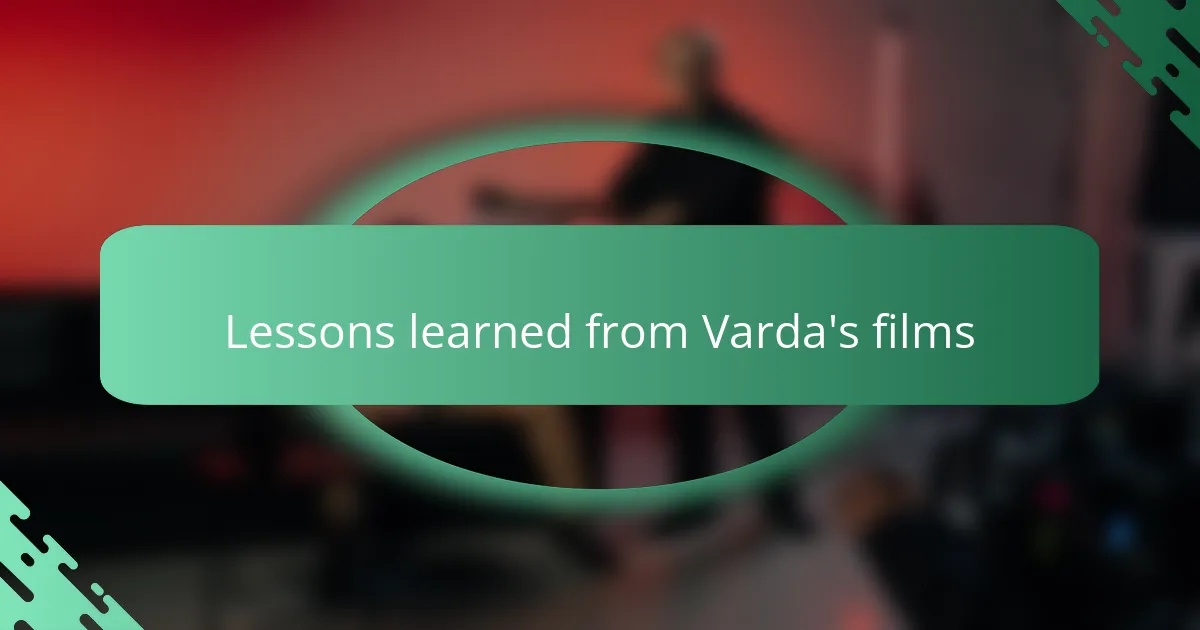
Lessons learned from Varda’s films
Analyzing Agnès Varda’s films has been an enriching journey for me. One lesson that stands out is her ability to blend documentary with fiction. I find that this approach creates layers of authenticity and emotional depth, allowing the audience to connect with the characters on a personal level. It reminds me of a time when I immersed myself in a documentary, only to realize how much it resonated with my own experiences.
Another significant takeaway is Varda’s use of imagery and sound to evoke emotion. Her films often make me reflect on my own memories and feelings, showcasing how powerful visual storytelling can be. I remember watching “The Gleaners and I” and feeling a mix of nostalgia and introspection, which connected me to the themes of memory and impermanence.
Here’s a comparison table highlighting some key aspects of Varda’s work:
| Film | Thematic Focus |
|---|---|
| Cléo from 5 to 7 | Existentialism and femininity |
| The Gleaners and I | Memory and cultural identity |
| Vagabond | Freedom and isolation |
